
An ambulance is a medically equipped vehicle which transports patients to treatment facilities, such as hospitals. Typically, out-of-hospital medical care is provided to the patient during the transport.

A fire engine is a road vehicle that functions as a firefighting apparatus. The primary purposes of a fire engine include transporting firefighters and water to an incident as well as carrying equipment for firefighting operations in a fire drill. Some fire engines have specialized functions, such as wildfire suppression and aircraft rescue and firefighting, and may also carry equipment for technical rescue.

Traffic lights, traffic signals, or stoplights – also known as robots in South Africa – are signalling devices positioned at road intersections, pedestrian crossings, and other locations in order to control the flow of traffic.

An emergency vehicle is a vehicle used by emergency services. Emergency vehicles typically have specialized emergency lighting and vehicle equipment that allow emergency services to reach calls for service in a timely manner, transport equipment and resources, or perform their tasks efficiently. Emergency vehicles are usually operated by authorized government agencies, but some may also be operated by private entities where permitted by law.

A siren is a loud noise-making device. Civil defense sirens are mounted in fixed locations and used to warn of natural disasters or attacks. Sirens are used on emergency service vehicles such as ambulances, police cars, and fire engines. There are two general types: mechanical and electronic.
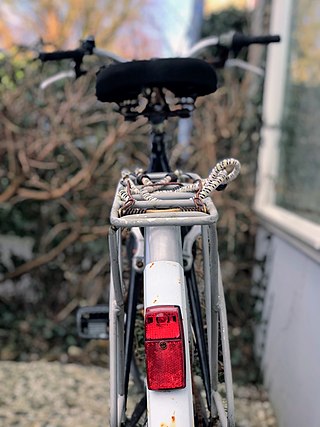
Bicycle lighting is illumination attached to bicycles whose purpose above all is, along with reflectors, to improve the visibility of the bicycle and its rider to other road users under circumstances of poor ambient illumination. A secondary purpose is to illuminate reflective materials such as cat's eyes and traffic signs. A third purpose may be to illuminate the roadway so that the rider can see the way ahead. Serving the latter purposes require much more luminous flux and thus more power.

A police car is a ground vehicle used by police and law enforcement for transportation during patrols and responses to calls for service. A type of emergency vehicle, police cars are used by police officers to patrol a beat, quickly reach incident scenes, and transport and temporarily detain suspects, all while establishing a police presence and providing visible crime deterrence.

A motor vehicle has lighting and signaling devices mounted to or integrated into its front, rear, sides, and, in some cases, top. Various devices have the dual function of illuminating the road ahead for the driver, and making the vehicle visible to others, with indications to them of turning, slowing or stopping, etc., with lights also indicating the size of some large vehicles.
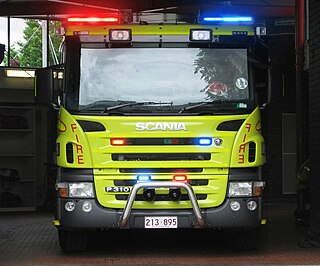
Emergency vehicle lighting, also known as simply emergency lighting or emergency lights, is a type of vehicle lighting used to visually announce a vehicle's presence to other road users. A sub-type of emergency vehicle equipment, emergency vehicle lighting is generally used by emergency vehicles and other authorized vehicles in a variety of colors.
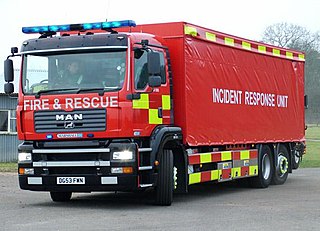
Emergency vehicle equipment is used in the United Kingdom to indicate urgent journeys by an emergency service. This usage is colloquially known as "blues and twos", which refers to the blue lights and the two-tone siren once commonplace. A call-out requiring the use of lights and sirens is often colloquially known as a "blue light run".
Traffic signal preemption is a system that allows an operator to override the normal operation of traffic lights. The most common use of these systems manipulates traffic signals in the path of an emergency vehicle, halting conflicting traffic and allowing the emergency vehicle right-of-way, thereby reducing response times and enhancing traffic safety. Signal preemption can also be used on tram, light-rail and bus rapid transit systems, to allow public transportation priority access through intersections, and by railroad systems at crossings to prevent collisions.
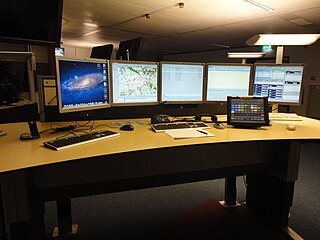
Emergency service response codes are predefined systems used by emergency services to describe the priority and response assigned to calls for service. Response codes vary from country to country, jurisdiction to jurisdiction, and even agency to agency, with different methods used to categorize responses to reported events.
Federal Signal Corporation is an American manufacturer headquartered in Oak Brook, Illinois. Federal Signal manufactures street sweeper vehicles, public address systems, emergency vehicle equipment, and emergency vehicle lighting.

Police in the United Kingdom use a wide range of operational vehicles, including compact cars, powerful estates and armoured police carriers. The main uses are patrol, response, tactical pursuit, and public order policing. Other vehicles used by British police include motorcycles, aircraft, and boats.

CEN 1789:2020 is the European Union standard for ambulances and medical transportation vehicles. This European standard specifies requirements for the design, testing, performance and equipping of road ambulances used for the transport and care of patients. This standard is applicable to road ambulances capable of transporting at least one person on a stretcher.

Courtesy lights are used to request right-of-way primarily by volunteer or on-call firefighters, emergency medical technicians (EMTs), and other first responders to expedite their response in their privately owned vehicles to their firehouse, base, or directly to the scene of an emergency call. Courtesy lights sometimes allow the user to disobey traffic laws such as speed limits, but usually not laws applying to stop signs or stop lights. Courtesy lights should not be confused with emergency warning lights used in conjunction with audible warning systems (sirens) for emergency vehicles such as police cars, fire apparatus, ambulances, etc, nor should they be confused with warning lights as used by tow trucks, snow plows, construction vehicles and school buses to increase awareness especially when moving slowly or stopped in the roadway.
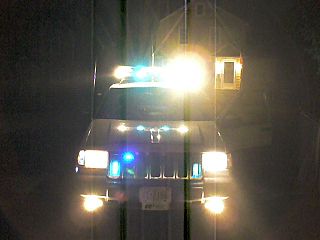
Premier Hazard is a manufacturer of emergency vehicle warning equipment, based in Bridlington, East Riding of Yorkshire, England.

A firefighting apparatus or firefighting appliance describes any vehicle that has been customized for use during firefighting operations. These vehicles are highly customized depending on their needs and the duty they will be performing. These duties can include firefighting and emergency medical services.

Police Vehicles in Japan are vehicles used by the prefectural police officers used for patrolling consisting of wide variety of vehicles depending on the environment and situation. Most police vehicles in Japan are manufactured by domestic automakers such as Toyota, Nissan or Subaru. Unlike how some departments in the U.S. and Canada allows their officers to take-home their police vehicles, Japan does not allow the officers to take home any kind of law enforcement vehicle. Every marked police patrol vehicles are in black-and-white two tone livery, motorcycles are usually all white. Vehicles for riot police units are painted blue and white, and especially vehicles for the Rescue Squads of the TMPD are painted green and white. The formal name is "警邏車" (keirasha), but in general the abbreviation "パトカー " is widely used.
Designs of level crossings, where railway lines cross roads or other paths, vary country-to-country.























